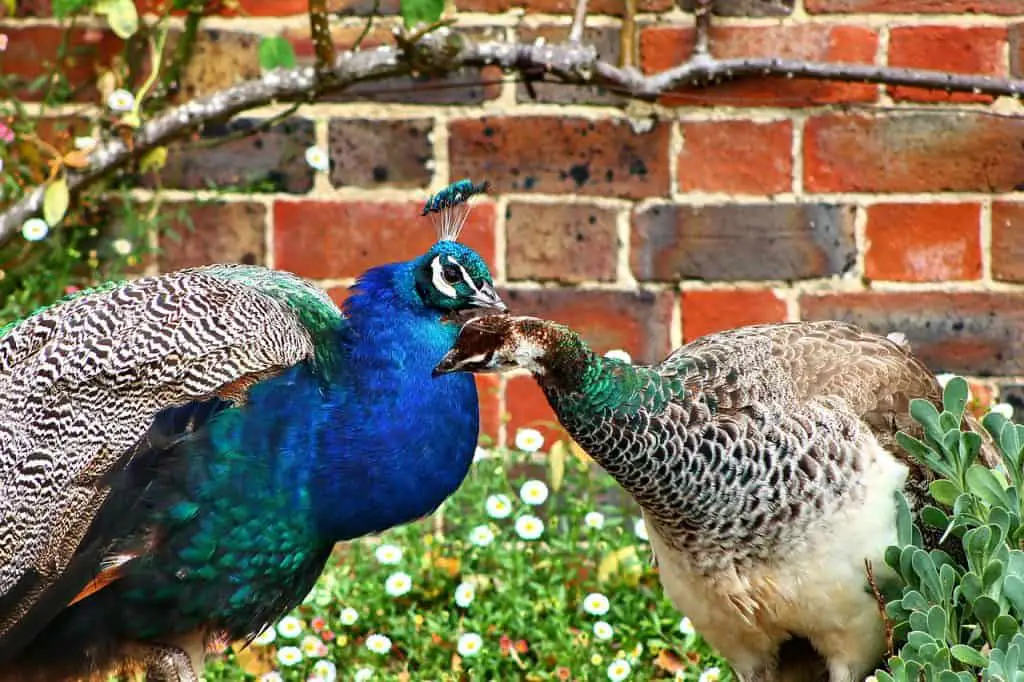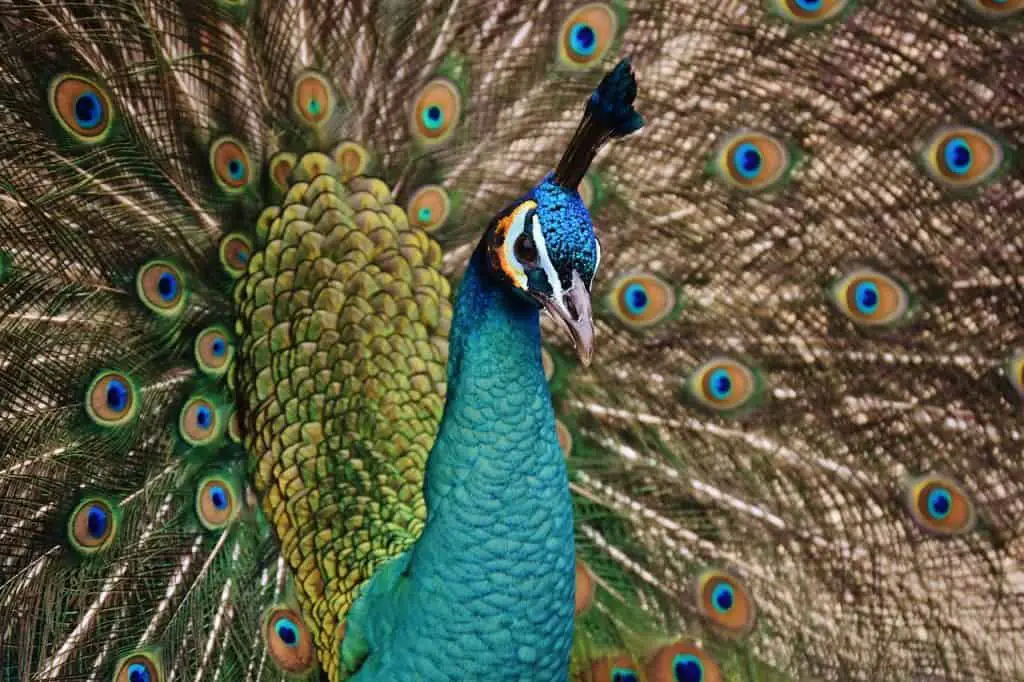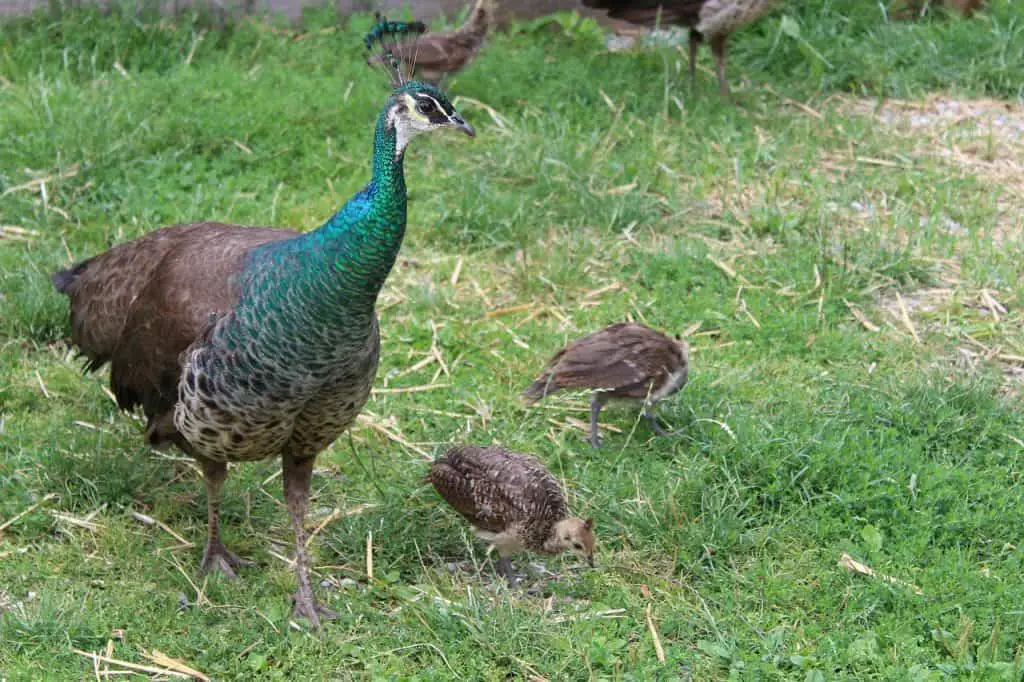When you think of a peacock, the male bird is likely what springs to mind. In fact, the word itself, “peacock,” refers to the male version of a peafowl. But of course, male peafowl (peacocks) have a female counterpart, officially called peahens. Female peacocks are the unsung heroes of this bird species. After all, the peacocks simply couldn’t get by without them!
In this article, you’ll find a useful guide to help you identify female peacocks. Plus, I share a bit more about the more subtle peahens’ traits and tendencies.
Key facts:
- Female peacocks are smaller than male peacocks.
- Female peacocks have more subtle feather colors than their male counterparts.
- Female peacocks are called peahens.
How to Tell if a Peacock is Male or Female
If you are looking at a group of peafowl, you’ll likely be able to sort the males from the females quickly. The key distinction is that female peafowl are more subtle than the grandiose male peacock that we are all familiar with. Below is a breakdown of the physical differences between male and female peafowl.
Coloration Differences: Male vs Female Peacocks

(Note: Male peacock on left. Female peahen on the right.)
Male and female peacocks exhibit distinct differences in their physical characteristics, making it possible to identify them with relative ease. The male peacock showcases elaborate and colorful plumage. Its long, vibrant tail feathers, called the train, are adorned with striking patterns and hues. The feathers on the male peacock’s tail highlight ocelli, or eyespots. The mix of metallic green, blue, and bronze make for a striking bird.
Additionally, the male peacock boasts a brightly colored head and neck, which further contribute to its eye-catching appearance. These striking features, combined with the male’s larger size and overall stature, make it easily distinguishable from the female.
In contrast, female peacocks possess more subtle plumage compared to their male counterparts. Their tail feathers are shorter and less vibrant, lacking the distinctive patterns seen in males. The coloration of their head and neck is also duller and less pronounced. Overall, female peacocks have a more modest appearance, characterized by a combination of earthy tones and muted shades.
Size: Male vs Female Peacocks
Size differences play a significant role in distinguishing between male and female peacocks. Male peacocks, often referred to as peafowls, are noticeably larger and more imposing than their female counterparts. On average, males can reach a height of up to 6 to 8 feet (1.8 to 2.4 meters) at the shoulder, with a total length, including the tail, exceeding 5 feet (1.5 meters). Their robust build and larger size contribute to their majestic presence in the wild.
In contrast, female peacocks are relatively smaller in size. They typically stand at a height of around 2 to 2.5 feet (0.6 to 0.8 meters) at the shoulder and have a total length, including the tail, of approximately 3 to 4 feet (0.9 to 1.2 meters). The size difference between males and females is particularly noticeable when they are observed together, with the males towering over the females.
Sounds: Male vs Female Peacocks
Peacock vocalizations differ between males and females, reflecting their distinct roles in communication and breeding. Male peacocks are known for their loud and captivating calls, which are often referred to as “screams” or “shrieks.” These vocalizations are deep, resonant, and carry over long distances, serving as a means to establish territory, attract mates, and assert dominance.
Personally, I’ve been woken up by the sound of a shrieking male peacock in the middle of the night. (You never know what’s living in South Florida!) I can attest that it’s not a pleasant sound to behold.
In contrast, female peacocks have a more subtle vocal repertoire. Their calls are softer and often described as “whistles” or “chirps.” Female vocalizations are primarily used during courtship interactions with males or to communicate with their young, providing a means of coordination and connection within the peafowl social structure.
Peacock Courtship Behaviors

Peacock courtship behaviors are captivating displays performed by male peacocks to attract the attention of females. These rituals are characterized by active and intricate movements. During courtship, the male peacock fans out his vibrant tail feathers, forming an impressive display known as a “train.” He then proceeds to spread and shake his feathers, creating a mesmerizing visual spectacle.
As part of their courtship behavior, male peacocks engage in “train-rattling” or “train-quivering,” where they rapidly vibrate their long tail feathers. This movement produces a distinctive rustling sound that accompanies the visual spectacle, further enhancing the allure of the courtship display.
Accompanying the visual and auditory displays, male peacocks engage in a series of elaborate dances. They rhythmically strut and parade around the female, extending their necks, and puffing out their chests. This dance is accompanied by fluttering of wings and occasional leaps into the air. The male peacock aims to captivate the female’s attention with these dynamic and captivating courtship behaviors.
Ultimately, peacock courtship behaviors showcase the male’s vitality, vigor, and genetic fitness, acting as a form of competition among males to secure a mate. Female peacocks tend to choose their mates based on the number of ocelli the male has, which means that older males with a track record of survival tend to pass on their genetic material.
Also, male peacocks mate with several peahens in a breeding season. After successfully wooing one peahen, they will move on to try and attract more mates.
Peafowl Parenting Behaviors

After mating and successful fertilization, the female peacock will seek out a suitable nesting site where she will lay her eggs. Once the eggs are laid, the female peacock takes on the responsibility of incubating them.
During the incubation period, which lasts about a month, the female peacock diligently tends to the eggs, ensuring they remain warm and protected. She carefully rotates the eggs to maintain an optimal temperature and humidity, using her beak and feet to gently move them.
After the eggs hatch, the female peacock continues to raise her clutch alone. The male doesn’t participate in raising the next generation of peafowl.
Female Peacocks: Frequently Asked Questions
You have questions about female peacocks. I have answers.
What is a female peacock called?
The term peacock refers to the male peafowl. Female peacocks are known as peahens.
What’s the difference between a male and female peacock?
The main differences between male and female peacocks lie in their physical appearance. Males have elaborate and colorful plumage, including a vibrant tail with striking patterns, while females exhibit more subtle and less vibrant plumage. Additionally, males are larger in size compared to females.
Final Take on Female Peacocks
Female peacocks aren’t as flashy as their male counterparts. While female peacocks are still beautiful birds, their subtle nature means they tend to fade into the background. The glory of male peacock feathers tend to make the males easier to spot. But if you are patient and know what to look for, you might spot a beautiful peahen.